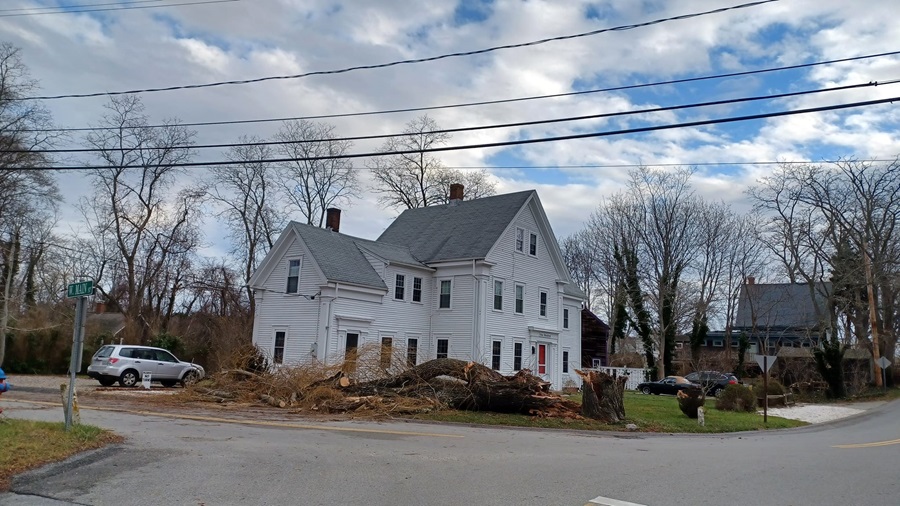WELLFLEET — The weeping willow on the corner of West Main Street, which rose above adjacent white clapboard houses, dangled its green catkins over the road’s sharp turn, and endured countless nor’easters and a decade of blight, had become a landmark for generations of its neighbors when its trunk finally cracked, and the tree fell during the Dec. 18 windstorm.
The following morning, Farrukh Najmi, a neighbor on Old Chequessett Neck Road, walked by the downed tree and saw the immensity of the loss stretched out before him.
“A long time ’Fleetian that I loved dearly passed away in last night’s storm,” Najmi wrote on the Wellfleet community page on Facebook. His post was accompanied by photos of the willow, both alive and mighty and in repose.

A flood of eulogies followed: “it will be so missed,” “a Wellfleet icon,” “such a beautiful tree,” “decompose in peace,” the social media comments read. Townspeople lamented the loss, shared stories of the tree, and composed a collective requiem.
“I had no idea it meant so much to so many besides me,” Suzanne de Bronkart said. One of the tree’s neighbors, De Bronkart, moved into an apartment with a view of the tree 30 years ago. She remembers the first time she turned the corner where it stood like a friendly sentry. “My heart leapt,” she said. “I was instantly in love with that amazing tree.”
Thirty years ago, the house at 100 West Main where the tree stood belonged to Diana Worthington, who had lived there since the ’70s. She took care of the willow, clipping and pruning it every spring. “It was a strong part of my life there,” she told the Independent. “It was welcoming. I know that anyone who came around that corner felt that way.”
Through the years, tenants came and went, Worthington said. But the tree remained. “God bless that tree,” she said.
Heidi Dyer lived across the street from the willow in the ’80s. “I remember lying in bed during windstorms, and I could hear it creaking and the branches rubbing,” Dyer said. “It wasn’t scary, it was soothing — like your old friend reminding you that they were there.”

Seth Rolbein bought the property from Worthington in the late ’90s. He turned the building into a condominium association made up of five units and named it the Willow Condominiums.
De Bronkart recalled a mail carrier telling her how a generation ago the marsh across the street was a pond that kids would skate on in the winter. The tree thrived there.
“Willow trees love having their feet wet,” Rolbein said. The roots of willows are aggressive and extensive, able to reach over 100 feet. They are even known to break pipes in their pursuit of water. Fifteen years ago, de Bronkart said, the dept. of public works discovered that the willow’s root system had invaded the catch basin below Main Street, sucking up the water and leaving the street prone to flooding. “They had to literally get down there in wetsuits to clear out all the roots,” she said.
Many long-time residents of the neighborhood agreed that the tree had been there for as long as they could remember. But while willows have amazing tenacity, their typical lifespan is relatively short — about 50 years.
Worthington said that in the 1970s the tree was already taller than the house. “It was bigger than all of us,” she said, referring not only to its size.
Dennis Townsend of RW Townsend and Sons has cared for the tree for the past 15 years. He said that the tree’s rotting, ant-eaten core made its age impossible to discern. “The only way to get a grasp on its age would be through pictures,” Townsend told the Independent.
Willow Condominiums resident Mike Page found a photograph of the house from the 1890s at the Wellfleet Historical Society. In the picture, the house is surrounded by four large oak trees and not a single weeping willow.

Page says his mourning has been tempered by a sense of relief. He had been worrying about the fate of the aging tree. “As much as it was a source of joy, it was equally a source of paranoia,” Page said. In the past 15 years, he said, the tree has been hit with blight, aphids turned the sturdy trunk into a wet sponge, and large pieces began to fall from the crown.
During nor’easters, fallen branches had taken down power lines and smashed the windshield of Page’s car. “I had a gut feeling when I got home that afternoon that I should not park my car in my usual spot,” Page said. “It still got hit, but at least I still have a car.”
Still, Page said, he will miss the tree’s company. “It was a birdwatching tree for me,” he said. “I will miss watching a new family of sparrows move into a home every spring.”
After the storm, Townsend, with the help of the DPW, removed the tree and sheared its still-standing bole down to a flat stump. In the days following the storm, repair companies came to the property to clear water that had pooled in the basement and fix a blown heater.
“They asked, ‘What are you going to call the association now?’ ” Page said. “I think we will call it the Willow Stump Condominiums.”
But that name might not last, Page said. Willow trees are fast regenerators, their roots host to nutrients that allow a stump to easily produce fresh growth. Even as soon as next spring, the willow on West Main could send up new green shoots.
If green does come, Worthington said, “may it be as beautiful as its parent.”
